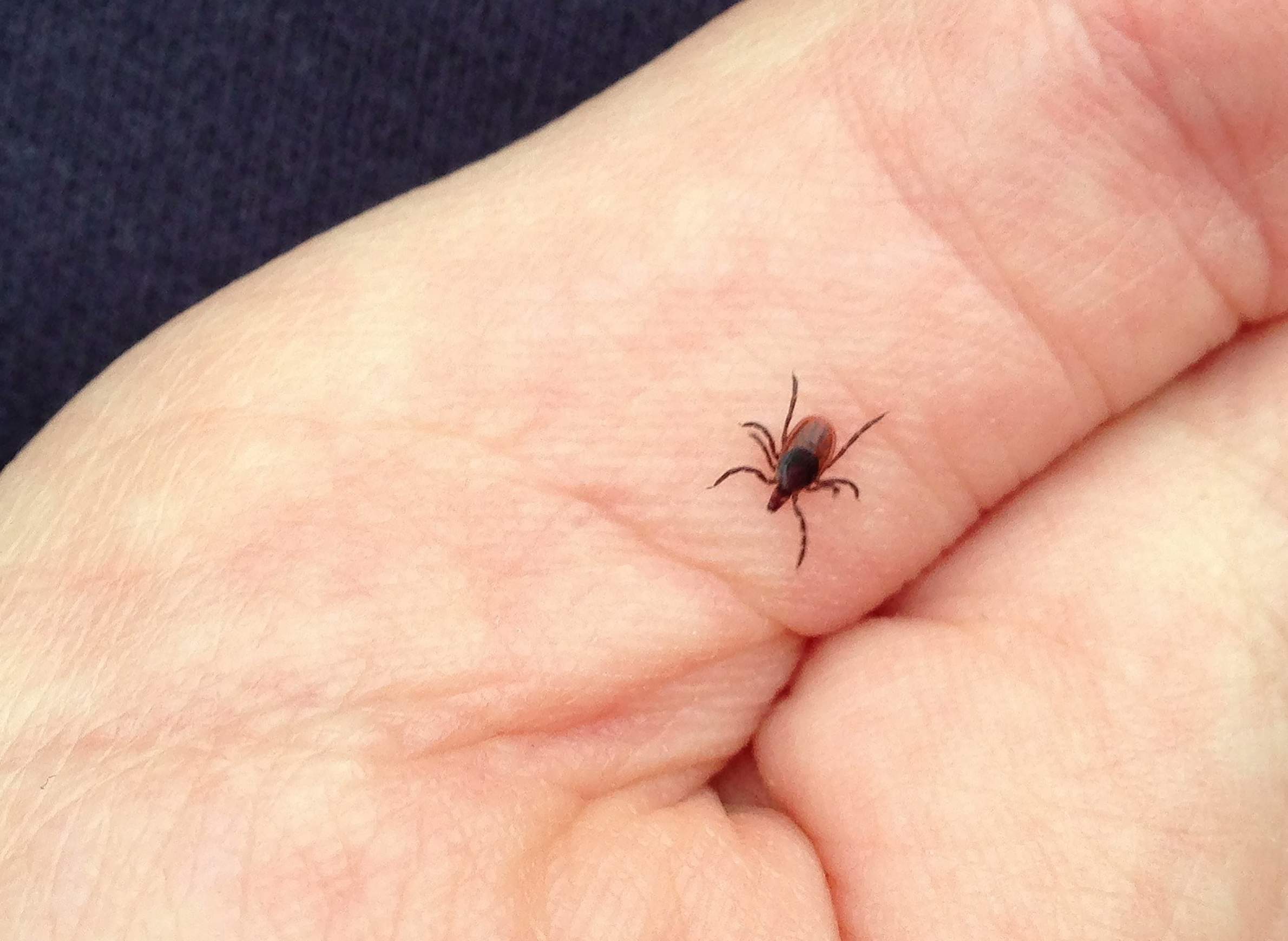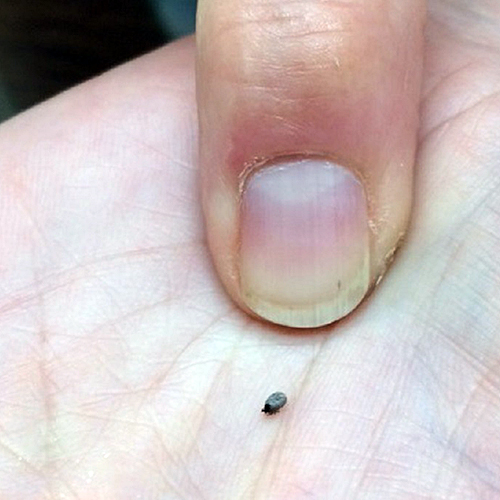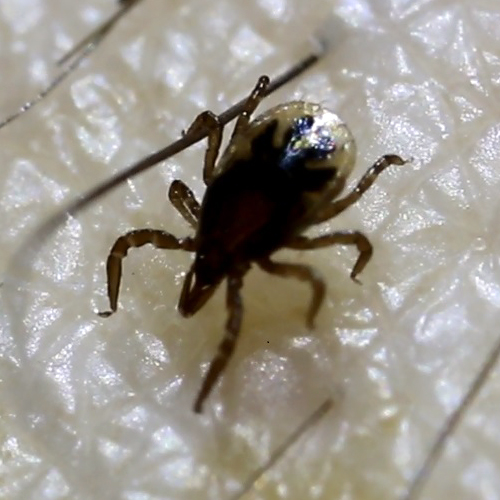
Encountering Backyard Bloodsuckers? The Tick App Tracks That

With peak tick season imminent in the upper Midwest, researchers at the University of Wisconsin-Madison are hopeful more people will download and use a free smartphone app that helps track and identify the tiny blood-sucking arachnids.
The Tick App launched in Wisconsin in time for the 2018 tick season, and more than 600 people in the state have downloaded it so far. The app is part of a behavioral study being carried out by researchers at UW-Madison and Columbia University in New York who are seeking to better understand where and how people encounter ticks. They're particularly interested in finding out what activities people are doing (and where they're doing them) when they encounter black-legged (or deer) ticks (Ixodes scapularis), which often carry the bacterium that causes Lyme disease.
About 20-30% of deer ticks can be infected with Borrelia burgdorferi, the disease-causing bacterium, explained Lyric Bartholomay, who studies diseases in ticks and other invertebrates in the Department of Pathobiological Sciences at the UW-Madison School of Veterinary Medicine. Bartholomay spoke about the Tick App and tick-borne diseases during a May 29, 2019 interview on Wisconsin Public Radio's The Morning Show.
"A lot of the ticks you might encounter could be infected with the bacteria," Bartholomay said. "If they feed on you and they stay attached to you for at least 36 hours, they can pass it on just with their saliva as they’re stuck to you and blood-feeding."
Bartholomay said between 70 and 80% of people who become infected with the Lyme-causing bacterium as a result of a deer tick bite will develop a classic bullseye rash around the site of the infection. That leaves a significant number of people who might not realize they're infected or were bitten in the first place. This risk is heightened by the fact that deer tick nymphs are tiny: about the size of a small freckle — and therefore are difficult to detect.
Deer ticks pick up the Lyme-causing bacterium while feeding on mice or other rodents during their larval stage, and they can pass it on to humans while feeding during their nymphal and adult stages.
The risk for Lyme disease may also be spreading geographically around the state beyond what had previously been understood. Ticks in Wisconsin, including deer ticks, are common in the state's wooded and agricultural areas, but they're also showing up more and more in the state's cities and suburbs.
"They're increasingly encroaching into our backyards and across the state," Bartholomay said on WPR.
This incursion likely means more people could encounter them while working or relaxing in their backyards, in addition to those who hike, hunt or camp in the woods. Pinning down precisely where people are picking up ticks is one of the main goals of the Tick App developers, who hope to increase the number of users in 2019 to around 2,000.
"We actually were finding ticks in places where we didn’t really expect them," said Susan Paskewitz, a professor of entomology at UW-Madison who also is involved in the app project, in an interview with WisContext. "We're finding them out in mowed grass. People need to think about being careful even in their backyard."
This may mean wearing clothing treated with permethrin, an insecticide that works well against ticks.
Both Paskewitz and Bartholomay are affiliated with the Midwest Center for Excellence in Vector Borne-Disease headquartered in Madison. It is part of a nationwide network funded by the Centers for Disease Control and Prevention to enhance preparedness to diseases like Lyme, as well as Zika and other mosquito-borne illnesses. The Madison-based researchers teamed up with colleagues at the Northeast Regional Center for Excellence in Vector-Borne Diseases to develop the Tick App.
Lyme is the most common vector-borne disease in the United States, though it is concentrated in regions where deer ticks are common.
The disease is most prevalent in parts of the northeastern U.S., including wide swaths of New England. It didn't appear in Wisconsin until the 1960s, but in recent decades the state has had the highest number of Lyme cases outside the Northeast. In 2017, the CDC recorded at least 3,000 confirmed and probable cases of Lyme in Wisconsin, double the number of cases in 2016 and a 10-year high.
During its first year, more people downloaded the Tick App in Wisconsin than elsewhere. Paskewitz said the app needs more users — who are more active — before it can help her team better understand risk behaviors for tick exposure, though.
"We had decent adoption, but we need to do it again this year because we didn't get very many reports of tick contacts [last year]," Paskewitz said.
In addition to providing resources for identifying ticks — including the ability to upload photos for expert analysis — the app prompts users to record daily entries in a "tick diary," whether they encountered ticks or not. The entries would ideally include the location of users' outdoor activities to help researchers understand where people are encountering ticks as well as where they aren't.
A new app feature in 2019 also provides users with a tick risk forecast for their location. The forecast is based on historical tick prevalence.
And it's not only deer ticks that the Tick App developers are interested in tracking.
Paskewitz said users who record encounters with any species can help provide a clearer sense of just how widely ticks are spreading in the state. These include the Lone Star tick (Amblyonmma americanum), which is rare in Wisconsin but can carry the deadly Rocky Mountain spotted fever and cause a severe allergic reaction to meat. The wood (or dog) tick (Dermacentor variabilis), which is common in Wisconsin, can also very rarely carry Rocky Mountain spotted fever. The state recorded its first ever death from the disease in 2018 after a woman in the La Crosse area became infected following a tick bite.
On top of that, Paskewitz said the app may help track the movement of a quickly spreading invasive tick, known as the longhorned tick (Haemaphysalis longicornis). Originally from East Asia, the species is becoming a major livestock pest in parts of the eastern and southern U.S., and models point to it possibly establishing in Wisconsin.
Paskewitz said the longhorned tick can often be distinguished from other species by its behavior: it tends to gather in large groups that feed on wild animals and livestock. Its large numbers are partly a result of its ability to reproduce asexually — females do not need males to fertilize eggs.
"They can spread very easily," Paskewitz said, asking anyone who encounters large masses of ticks, or any tick they can't identify and suspect to be a species uncommon in Wisconsin, to immobilize the critters for identification. For example, the UW Insect Diagnostic Lab in Madison will identify tick specimens sent in by Wisconsin residents.
"Take a piece of masking tape and get as many immobilized on it and then pop it in the freezer," she said. "Especially if anybody who works as a vet or in the livestock industry were to encounter anything unusual tick-wise, we want to know."




